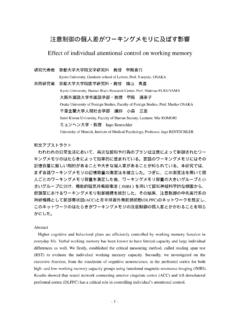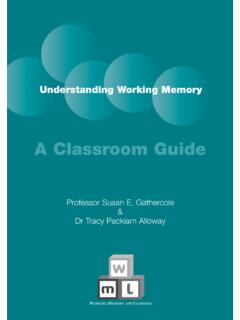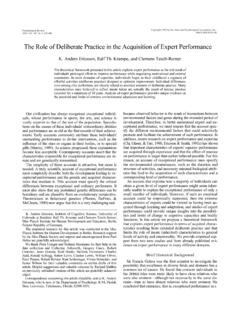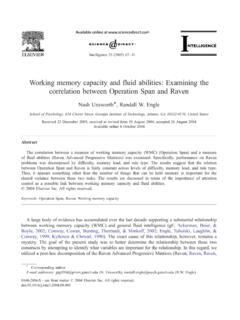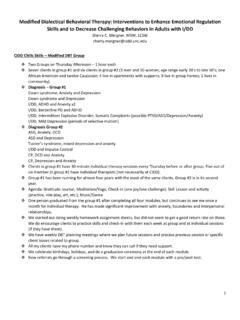Transcription of A review of the literature on social and emotional ... - ed
1 Department of Education What s Known A review of the literature on social and emotional learning for students ages 3 8: Characteristics of effective social and emotional learning programs (part 1 of 4) Rosemarie O Conner Jessica De Feyter Alyssa Carr Jia Lisa Luo Helen Romm ICF International social and emotional learning (SEL) is the process by which children and adults learn to understand and manage emotions, maintain positive relationships, and make responsible decisions. This is the first in a series of four related reports about what is known about SEL programs for students ages 3 8. The report series addresses four issues raised by the Regional Educational Laboratory (REL) Mid-Atlantic s Early Childhood Education Research Alliance: characteristics of effective SEL programs (part 1), implementation strategies and state and district policies that support SEL programming (part 2), teacher and classroom strategies that contribute to social and emotional learning (part 3), and outcomes of social and emotional learning among different student populations and settings (part 4).
2 This report identifies key components of effective SEL programs and offers guidance on selecting programs. Why this review ? To thrive in a social world, students must learn social and emotional skills, such as controlling their impulses, interpreting and understanding emotions, motivating themselves, and developing positive atti tudes toward school and community (Pianta & La Paro, 2003; Raver, 2002). Therefore, early childhood At ICF Internationalprograms aim to help students develop socially and emotionally in addition to fostering academic school readiness. This process, referred to as social and emotional learning, centers on the development of five interrelated sets of cognitive, affective, and behavioral competencies (CASEL, 2012). These five competencies include self-awareness, self-management, social awareness, relationship skills, and responsible decisionmaking (see box 1 for definitions). Moreover, students are exposed to social and academic information that they must interpret, analyze, and respond to in acceptable ways (Crick & Dodge, 1996).
3 Therefore, they need to develop self-regulation and executive functioning in addition to social and emotional skills. Executive functioning and self-regulation are the mental processes that enable students to plan, focus attention, remember instructions, and juggle multiple tasks successfully (Center on the Developing Child, 2011). Both self-regulation and executive func tioning influence social and emotional learning (figure 1). Accordingly, effective SEL programs, particularly in preschool, include approaches to enhance self-regulation and executive functioning. What the review examined Because of recent policy interest in social and emotional learning, a large amount of information is avail able about SEL programs and approaches, including literature reviews, research syntheses, practice guides, and meta-analyses. Members of REL Mid-Atlantic s Early Childhood Education Research Alliance identi fied the need for an organized summary that addresses school-based social and emotional learning for the general population of students ages 3 8, synthesizes the body of literature , and enables educators to easily identify the programs and strategies that are most appropriate for their setting and student population.
4 Box 1. Five competencies define social and emotional learning The Collaborative for Academic, social , and emotional Learning (CASEL) identifies these five interrelated compe tencies as central to social and emotional learning: Self-awareness. Knowing what one feels, accurately assessing one s interests and strengths, and maintaining a well-grounded sense of self-confidence. Self-management. Regulating one s emotions to handle stress, control impulses, and motivate oneself to perse vere in overcoming obstacles, setting and monitoring progress toward the achievement of personal and academ ic goals, and expressing emotions appropriately. social awareness. Being able to take the perspective of and empathize with others, recognizing and appreciat ing individual and group similarities and differences . Relationship skills. Establishing and maintaining healthy and rewarding relationships on the basis of coopera tion and resistance to inappropriate social pressure; preventing, managing, and constructively resolving inter personal conflict; and seeking help when needed.
5 Responsible decisionmaking. Making decisions based on a consideration of all relevant factors, including applicable ethical standards, safety concerns, and social norms; the likely consequences of taking alternative courses of action; and respect for others. Source: CASEL, 2012. 2 Figure 1. Relationship among executive functioning, self-regulation, and social and emotional learning Executive functioning The ability to plan, initiate, and follow through with goal-directed behavior. Involves impulse control, emotional control, flexibility, working memory , self-monitoring, planning and prioritizing, task initiation, and organization. Facilitates self-regulation. Provides the foundation for social and emotional learning. Self-regulation The ability to control one s emotional , behavioral, and cognitive actions and responses. Is a stress-response system. Shares three competencies: self-awareness, self-management, and social awareness.
6 Low self-regulation can lead to aggression, overactivity, inattention, and reduced academic achievement. The process by which children and adults learn to understand and manage emotions, maintain positive relationships, and make responsible decisions. Five interrelated competencies: self-awareness, self-management, social awareness, relationship skills, and responsible decisionmaking. Associated with executive functions such as the ability to delay gratification, manage conflicts, and learn in the classroom. Source: Bierman & Torres, 2015; Campbell, 2002; CASEL, 2012; Center on the Developing Child, 2011; Garon, Bryson, & Smith, 2008 Research questions With these goals in mind, the alliance developed four research questions to guide the project: 1. What are the characteristics of effective SEL programs? 2. What implementation strategies and state and district policies support SEL programming? 3. What teacher and classroom strategies contribute to social and emotional learning?
7 4. What outcomes have SEL programs demonstrated among different student populations and settings? These four research questions guided REL Mid-Atlantic s systematic search, review , and synthesis of recent (2008 15) research reviews and meta-analyses (rather than original studies and sources) on the topic of social and emotional The review found 83 research syntheses that met the study inclusion crite ria, including peer-reviewed journal articles, book chapters, reports, and online publications. Each synthesis was coded for criteria such as research question, methodology, relevant populations/ages, and settings. (The methodology and coding results are described in appendix A. The literature is mapped to the relevant research questions in appendix B.) The social and emotional learning report series Four related reports summarize the literature addressing each of the four research questions.
8 This report (part 1) focuses on the first research question on the characteristics of effective SEL programs. The other three reports offer guidance on program implementation and identify trends toward integrating this 3 social and emotional learning learning at the school, district, and state levels (part 2), describe teacher and classroom strategies (part 3), and provide evidence of student outcomes (part 4; O Conner, De Feyter, Carr, Luo, & Romm, 2017a, b, c). Each report can stand alone as a summary of the research literature on a specific topic. The reports can be read in any order. The first section (Why this review ?) and this section (What the review examined) of each report provide similar introductory information, with more detail on social and emotional learning and how it is related to executive functioning and self-regulation presented here in part 1. What the review found A surge in SEL research over the past few decades has begun to illuminate what works in SEL program design and implementation for yielding positive student and school outcomes (Barbarasch & Elias, 2009).
9 Most of the research that documents the impact of social and emotional learning on student outcomes used rigorous, randomized controlled experiments and tested a specific program. To assist educators and policymakers, this report presents information and recommendations from experts on selecting an evidenced-based SEL It reviews the literature on stand-alone, evidence-based SEL programs that are associated with positive student behaviors or academic performance. The literature also includes programs that target executive functioning. Many SEL approaches represent a hybrid of the two. Effective social and emotional learning programs share three characteristics Systematic reviews that summarized the evidence on the characteristics of effective SEL programs found three common characteristics: Use of a combination of techniques that are skills focused and environment focused. Use of a program that is sequenced, active, focused, and explicit (SAFE).
10 Provision of training and technical assistance for teachers. Most social and emotional learning programs use a combination of skills-focused and environment-focused techniques (Heller, 2013; Lantieri & Nambiar, 2012; Meyers & Hickey, 2014; Whitted, 2011). Skills-focused techniques involve explicit instruction in social and emotional skills. These techniques emphasize classroom-based lessons, direct instruction, and opportunities to practice social and emotional learning through role plays and modeling. Environment-focused techniques involve creating conditions that foster social and emotional skills. These conditions involve classroom climate, teaching practices, classroom management, and school initiatives. Integrating skills-focused and environment-focused techniques reflects an understanding that a student s social and emotional skills and the larger school environment influence each other.










